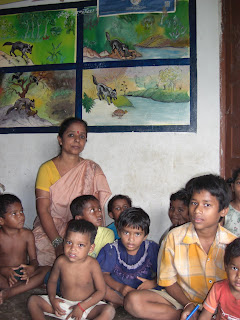



We visited Jilledupadu, a tribal village and saw some interesting seeds being dried out. These are called kosam, and they’re gathered from the forest. They grind the seeds for oil because it’s great for an itchy rash that comes in the rainy season. Some of the tribal villagers say that all who knew about the medicinal herbs are dead now, but it seems like there is still a lot of ‘common knowledge’.
The tribal folks are really interesting. Asha likes them a lot. She says they never lie. They have lots of festival days where they honor nature goddesses and gods from the forest (and party pretty hard). One of my favorite things about them is that they generally pay a bride price to the bride’s family, rather than the dowry that everyone else pays.
The dowry phenomenon is mystifying to me, and a huge problem for so many people. Dowry has been outlawed officially, but is still demanded by most families. The women that I see are working all day long to grind food and cook all the meals, haul the water, maintain the home, bear and raise the children. They’re very restricted in what they’re allowed to do outside the home (ie, they’re not allowed to leave it!). In many ways, the wife is essentially a domestic servant for the husband and his family; I can’t imagine why she should pay her husband to take her in! And if she’s educated or has some job of her own, she has to pay an even higher dowry!
Sometimes “dowry harassments” occur. That means, if the whole price isn’t paid to the inlaws, after the wedding they give the bride a hard time, pressuring her and her family. Sometimes this ends in suicide or even murder.
In some of the villages we visited, the rates of consanguinity are as high as 30%. This is because if you marry a cousin, you don’t have to pay a dowry. One woman told me about her 2 grandchildren that had died, and showed me her 3rd grandchild, age 6, developmentally delayed, destined to die within 2 years because of some inherited metabolic disorder.
Families hope for male children because they worry they just won’t be able to pay dowries for their daughters. The practice of abortion because the fetus is female is totally illegal, but it still happens.
Wow, I really wanted this blog entry to be a happy one! Let me end with a nice story: The other day I was attending a meeting – quite boring all in Telegu, so I went for a little walk down the road. Everyone was watching, cause after all, it’s very entertaining watching a foreigner walk down the road! One guy on his motorcycle even slowed down. He had his wife riding sidesaddle like they do, and 2 kids and some packages all packed on there, too. After he passed me, he stopped, I just figured the kids were really getting a kick out of how pale I am. Then he said, “Madam, please...” indicating that I should take a place on the seat, with everyone else! He was so concerned for me! It was so incredibly sweet, and people are doing things like that all the time here.















